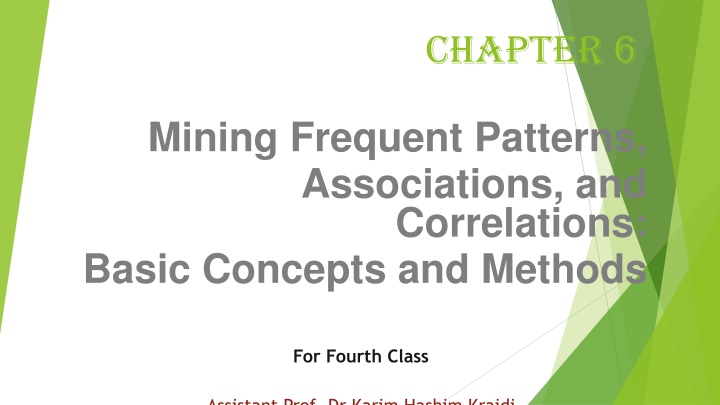
Mining Frequent Patterns: Basic Concepts and Methods
Explore the fundamental concepts and methods of mining frequent patterns, associations, and correlations in data sets. Discover the significance of identifying frequent patterns in various data mining tasks such as classification and clustering.
Download Presentation

Please find below an Image/Link to download the presentation.
The content on the website is provided AS IS for your information and personal use only. It may not be sold, licensed, or shared on other websites without obtaining consent from the author. If you encounter any issues during the download, it is possible that the publisher has removed the file from their server.
You are allowed to download the files provided on this website for personal or commercial use, subject to the condition that they are used lawfully. All files are the property of their respective owners.
The content on the website is provided AS IS for your information and personal use only. It may not be sold, licensed, or shared on other websites without obtaining consent from the author.
E N D
Presentation Transcript
Chapter 6 Mining Frequent Patterns, Associations, and Correlations: Basic Concepts and Methods For Fourth Class Assistant Prof. Dr Karim Hashim Kraidi
Introduction Frequent patterns are patterns (e.g., itemsets, subsequences, or substructures) that appear frequently in a data set. For example, a set of items, such as milk and bread, that appear frequently together in a transaction data set is a frequent itemset. A subsequence, such as buying first a PC, then a digital camera, and then a memory card, if it occurs frequently in a shopping history database, is a (frequent) sequential pattern. A substructure can refer to different structural forms, such as subgraphs, subtrees, or sublattices, which may be combined with itemsets or subsequences. If a substructure occurs frequently, it is called a (frequent) structured pattern. Finding frequent patterns plays an essential role in mining associations, correlations, and many other interesting relationships among data. Moreover, it helps in data classification, clustering, and other data mining tasks. Thus, frequent pattern mining has become an important data mining task and a focused theme in data mining research.
Apriori Algorithm Apriori is a seminal algorithm proposed by R. Agrawal and R. Srikant in 1994 for mining frequent itemsets for Boolean association rules [AS94b]. The name of the algorithm is based on the fact that the algorithm uses prior knowledge of frequent itemset properties, as we shall see later. Apriori employs an iterative approach known as a level-wise search, where k-itemsets are used to explore .k C1/-itemsets. First, the set of frequent 1-itemsets is found by scanning the database to accumulate the count for each item, and collecting those items that satisfy minimum support. The resulting set is denoted by L1. Next, L1 is used to find L2, the set of frequent 2-itemsets, which is used to find L3, and so on, until no more frequent k-itemsets can be found. The finding of each Lk requires one full scan of the database. Eclat FP-Growth
Apriori Algorithm Example 6.3 Apriori. Let s look at a concrete example, based on the AllElectronics transaction database, D, of Table 6.1. There are nine transactions in this database, that is, jDj D 9. We use Figure 6.2 to illustrate the Apriori algorithm for finding frequent itemsets in D.






















